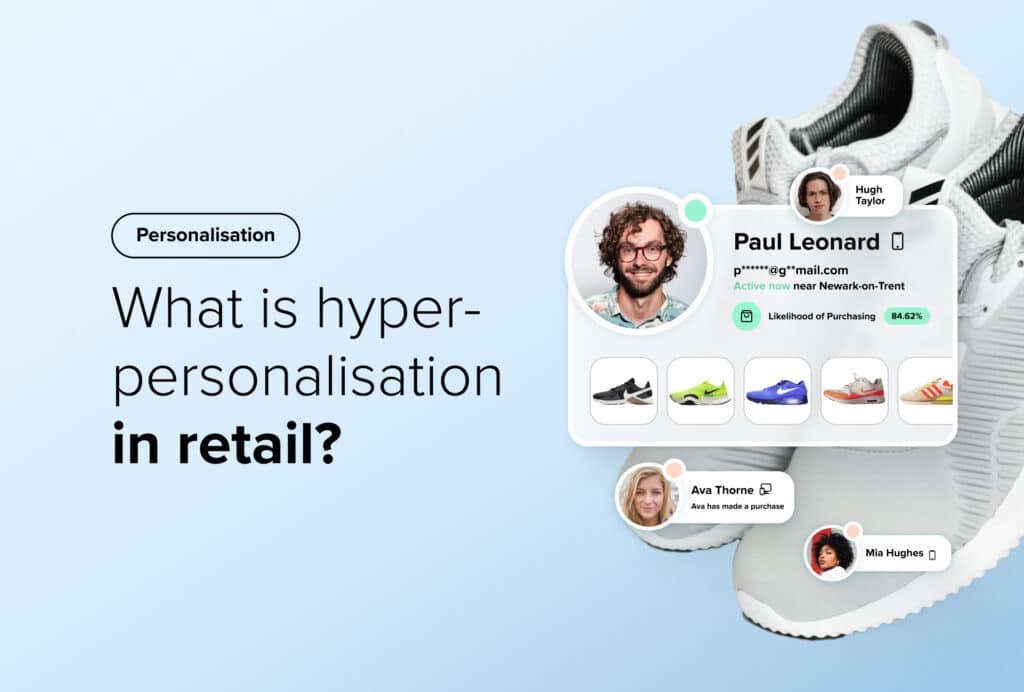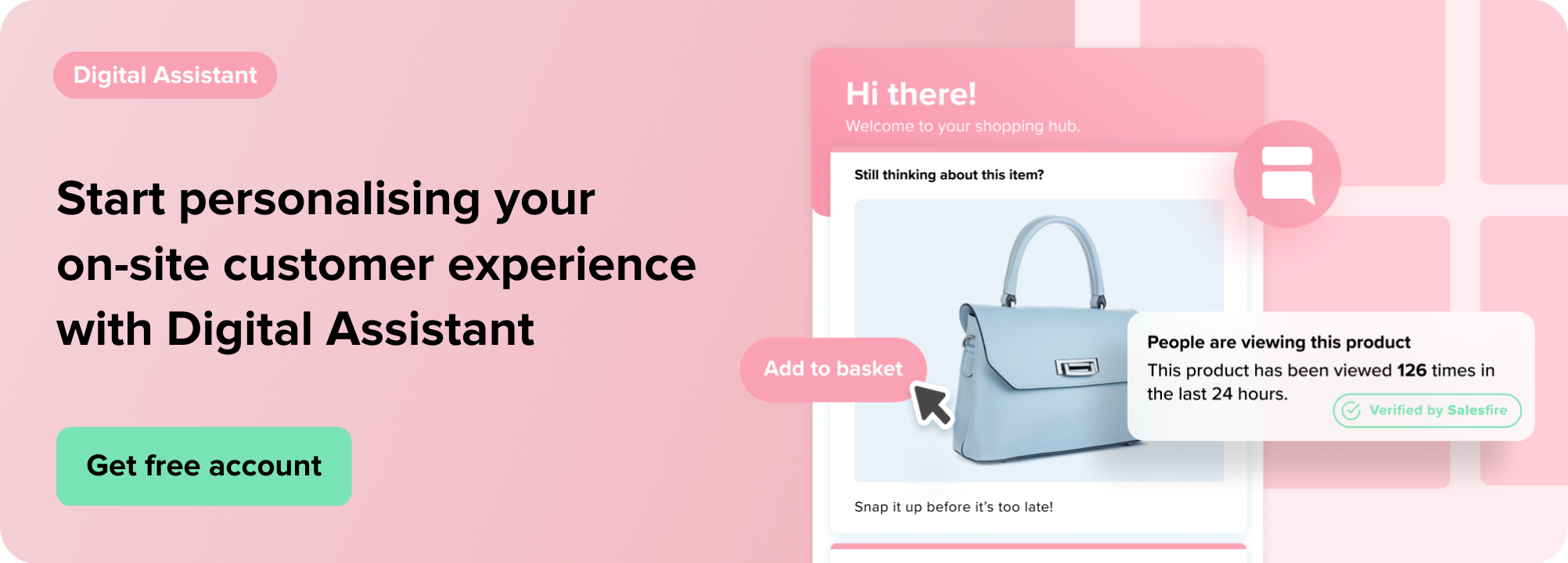Hyper-Personalisation in Retail is the Key to eCommerce Success | What it is and Why it’s Beneficial
By Bethany Llewellyn • Last updated: Thursday Jul 18th, 2024

In recent years, the term hyper-personalisation has gained significant traction in the eCommerce industry.
Leveraging artificial intelligence (AI) and customer data insights, hyper-personalisation is a game-changer for eCommerce strategies when utilised effectively.
By implementing hyper-personalisation into marketing strategies, retailers can ensure they’re ahead of the curve and provide streamlined user experiences to generate more revenue.
In this article, we’ll explore what hyper-personalisation is and how it differs from traditional personalisation, and then outline the benefits it can provide for eCommerce retailers.
Suggested: Watch our short video, ‘5 Reasons Why Website Personalisation Matters’, to learn more about the importance of personalisation in 2023.

What is hyper-personalisation in retail?
Personalisation is dominating eCommerce business strategies, and for all the right reasons.
Customers expect retailers to provide relevant, personalised browsing journeys online, so much so that 83% of consumers say they’re willing to share their data in return for a tailored experience.1
But what is the difference between eCommerce personalisation and hyper-personalisation, and why is it the way forward for eCommerce?
- Personalisation is based on general customer preferences and allows eCommerce businesses to provide tailored on-site experiences for their customers.
- Hyper-personalisation, however, is a different level of personalisation that goes beyond the standard triggers and recommendations that are commonly used on eCommerce sites.
Utilising AI and data-driven insights, hyper-personalisation allows you to provide truly relevant product recommendations, overlays and promotions that are unique to each shopper and genuinely meet their needs.
Using real-time data, you can ensure you provide a tailored experience for each individual customer that will work to:
- Improve customer satisfaction: By tailoring the on-site experience to the specific preferences of individual shoppers and providing an AI-driven product discovery experience.
- Boost customer loyalty: Provide personalised marketing that helps customers feel valued.
- Generate more sales: Use hyper-personalisation to encourage higher AOVs and support returning customers.
Research shows that 80% of consumers are more likely to purchase from a brand that offers personalised customer experiences, so if you aren’t already offering tailored on-site customer journeys, now is the time to start.2
The benefits of hyper-personalisation in online retail
1. Streamlining customer experiences
A key benefit of hyper-personalisation is its ability to provide tailored, streamlined customer journeys that work to increase overall customer satisfaction.
Since a streamlined customer journey is essential for great user experiences, reducing friction from a shopper’s path to purchase will help improve customer satisfaction, increase sales and improve customer retention.
Frustrations caused by poor on-site experiences can lead to higher abandonment rates as shoppers switch to competitor sites.
Here are some ways in which hyper-personalisation can streamline customer journey with data-driven customer experiences:
- Relevant promotions and product offerings: Using data insights from your customers’ browsing behaviour, you can showcase tailored promotions based on real-time behaviour to support their on-site journey and prompt them to complete a purchase.
- Simplified navigation: Ensure your homepage is easy to navigate to avoid bounce rates from the very first step. This might mean implementing AI-powered Search tools, or making the most of Visually Similar Search technology. You can take it further by creating dynamic landing pages that display content based on where users have clicked through to your site from, like social media or an ad, to keep the customer journey cohesive across different platforms.
- Personalised recommendations: AI-driven Recommendations analyse customer data in real-time to identify shopping patterns and connect users with their perfect purchase.
When shoppers feel that their wants and needs have been catered to, they are more likely to return and advocate for your brand to their family and friends. This kind of social proof can then further boost acquisition and retention, and help to establish your brand name and identity within the community.
Suggested reading: We cover all you need to know about providing seamless shopping experiences to your customers in our blog, ‘Seamless Shopping Experiences: The Secret to Increasing eCommerce Sales’. Read it now to learn more.
2. Reducing basket abandonment rates
Basket abandonment — when a customer adds items to their basket but leaves the website without completing a purchase — is a common problem in retail, and particularly in eCommerce.
The average shopping cart abandonment rate currently sits around 69%, meaning that the average eCommerce business is dropping around 31% of shoppers at the checkout stage, leading to lost sales.3
There are a whole host of reasons for cart abandoners, but there are also various tactics you can implement to optimise the user experience and prevent shoppers from leaving.
Here are ways you can use hyper-personalisation strategies to reduce your basket abandonment rate:
- Personalise the checkout page: Display customers’ recently viewed items to encourage shoppers to build bigger baskets and to create a more seamless and intuitive checkout experience.
- Offer relevant discounts or promotions: Harness your customer data to identify those uncertain shoppers who may need a final push to purchase. From here, implement an AI-powered personalisation tool to display relevant promotional Overlays or Recommendations.
- Utilise abandoned cart emails: Remind shoppers about items they left in their basket to encourage them to return and complete a purchase. Similarly, you can run ‘Recently Viewed’ campaigns using a Digital Assistant, that intelligently remembers and re-displays content that returning shoppers viewed on their last visit.
- Offer 24/7 customer support: Allow customers to quickly and easily find the answer they are looking for. By removing friction from the buyer’s journey, you’ll reduce the likelihood of them abandoning their purchase at the final stage.
Using hyper-personalisation at various points throughout the buyer’s journey, like on the homepage and product pages, will develop stronger customer relationships and build customer loyalty as the customer spends more time on your site.
As the shopper’s wants and needs are filled with relevant information at every stage, you’ll notice a decrease in bounce rate and abandonment rates.
Suggested reading: Read our blog, ‘How AI Drives Customer Loyalty’, to learn more about the place of AI technology in customer experiences.
3. Driving customer retention
Customer satisfaction and improving your retention rates go hand in hand — and hyper-personalisation is the powerful tool that’ll delight your customers and keep customers coming back time and again.
By offering promotions and deals relevant to each customer’s unique interests, you can be confident that your customers feel catered to and valued.
Leveraging the data you have on your customers, you can provide tailored recommendations-based product suggestions that can help both new and existing customers discover new products they’ll love. This kind of website personalisation will result in improved satisfaction, enhanced loyalty, and an increased lifetime value to the customer.
When it comes to customer retention, it’s not just the initial buying stages you want to focus on, but also the post-purchase experience. To keep customers coming back time and time again, try:
- Using email marketing campaigns to showcase your new products, sales or promotions.
- Encouraging social proof by being active on social media and engaging with customer reviews.
- Promoting mailing list sign-ups. By encouraging users to sign up for your mailing list, you can personalise your marketing efforts and re-engage shoppers further down the line with retargeting campaigns.
Since every step will be tailored to each individual customer you will create a sense of trust and connection with your customers that can lead to improved retention rates.
4. Improving brand image
Personalisation has become an essential component of eCommerce business strategies, and brands that embrace hyper-personalisation are seen as forward-thinking and customer-centric.
Using your customer data, you can provide a seamless shopping experience that differentiates you from your competitors whilst building a strong brand image.
Here are some ways in which hyper-personalisation can help improve brand image:
- Increases brand awareness: The eCommerce space is highly saturated with various businesses trying to target online shoppers. Using hyper-personalisation, you can cut through the noise and provide messaging that resonates with each individual customer to provide a memorable experience.
- Enhances customer engagement: Creating a meaningful and relevant experience for your customer will encourage users to engage with your content whilst creating an enjoyable on-site experience that’s tailored to them.
- Differentiates your brand: Similarly to improving brand awareness, you want to create a unique and tailored experience that creates a sense of exclusivity that sets you apart from the competition. It’s no secret that online retail is incredibly competitive; finding creative ways to make your brand identity unique is essential.
Customer segmentation is the process of dividing up customers based on their demographic, behaviours, or characteristics. Using customer segments to deliver targeted messaging to each audience will not only make your customers feel valued and seen but create a connection that sticks in your customers’ minds.
The stronger your relationship with your customers, the more likely they are to advocate for your brand.
Suggested reading: Discover the benefits of having a strong brand identity in our blog, ‘The Importance of Brand Identity to Encourage Repeat Customers’.
Hyper-personalisation is the future of eCommerce
Hyper-personalisation is changing the game for eCommerce by offering benefits that go beyond what traditional personalisation can provide.
By leveraging AI and customer data to provide unique experiences to each customer that visits your site, you can work to:
- Reduce basket abandonment
- Streamline the customer journey
- Improve brand image
- Enhance the customer experience
Hyper-personalisation is the future of retail and brands that fail to adapt and provide these personalised services risk falling behind their competitors.
Salesfire’s suite of conversion rate optimisation tools includes an AI-powered Digital Assistant, hyper-personalised Recommendations, advanced Search capabilities, and much more.
Explore our site today to learn more, or book a demo to try our platform for yourself.

2 80% of Consumers More Likely to Shop with Brands that Show they Understand Them | Business Wire
3 48 Cart Abandonment Rate Statistics 2023 – Cart & Checkout – Baymard Institute
See how Salesfire can help you optimise your product discovery experience, email one of our experts at [email protected] or book a free demo of our personalisation tools.



